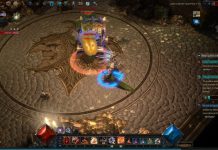Trion World’s Rift: The Planes of Telara is actually a hard MMO to do a “first impressions” for because it’s been out so long and I used to play it back when it was pay-to-play. As a result, this short review, as always, will focus on how new players will experience the game and how the free-to-play aspects have changed the landscape. For those not in the know, Rift is a free-to-play MMORPG with stunning AAA quality graphics and gameplay that attempted to be, in its time, a WoW-killer. Of course, like all WoW-killers in all of history, it failed to do that and instead added an interesting dynamic to the genre on its launch that is now being re-visited by other games.
As a title, Rift promoted a themepark MMO with a dynamic open world event system: the rifts. Not just an eponymous event, but basically the first-best idea of how dynamic events should work—wandering around the world all by your lonesome, when suddenly a tear opens up in the sky, and through that pours a strange amalgam of elemental material rushing into reality alongside bizarre geometry and twisted monsters. Soon, other players arrive, and an all out battle for the shape of the landscape takes place.
It was good for a while.
Rift went on for quite some time as a subscription-based pay-to-play game and then transitioned into a play-for-free-limited game that allowed players to get in for free until a certain level; but finally Trion succumbed to the free-to-play model and now it’s free straight through.
In all, it’s the same game that came out with a box and a subscription; but now it’s free-to-play, has a strong community, and even a lot of nice graphics and a broad world to experience.
Sound and Graphics: This is not the run-of-the-mill free-to-play MMO
To put it mildly, when it first came out Rift was a very good looking game–and it still is. The graphics run so high that it needed two modes to “gracefully” fail on systems that couldn’t handle the levels. The screenshots in this review will not do it justice. It has a particular edge to the textures that make it feel a little bit realistic and less cartoony than most MMO games and the art style is developed to provide a sort of really-there effect.
When targeting, mobs are highlighted with extra glow to make them jump out. This is in part because tweaking the color settings can be a little difficult, and models for undead and certain monsters can blend into the environment during the night. However, for the most part friend and foe are quite obvious–and then there’s even the weird.
As described, rifts change the very landscape when they emerge, as a result a lot of thought was put into how their textures interact with the world and how their animations reflect on the gameplay and immersion experience. If anything, a rift is an event that’s fun to participate in over and over because of the interesting effect that it places onto the world around it when it emerges. I’ve found myself sitting to watch the other plane of existence overtake rock and grass–and then, of course, watch it slowly recede and dissolve after the intruders have been dispatched.
All the models in this game are fairly high fidelity and it still looks pretty good.
The environments are very nice, lush with detail, grass, foliage (and settings to change those from spase to overgrown.) Everywhere in Telara there are buildings of different architecture, varied and thoughtful cultures, and interesting views to look at. Rift may not be a Guild Wars 2 but it has just enough artistry to stand right there with games like World of Warcraft when it comes to exploration and world.
The music is satisfactory–but, I suppose I’ve been hearing it for too many years. It also reminds me of the beginning when the world itself is being destroyed by the machinations of the people on Telara and the Lord of Death, Regulos himself, is coming to devour them. It has a sort of subtle orchestral hue to it that mingles nicely with the other sounds of the game, but I find myself forgetting its presence or altogether turning it off to play my own music.
There are numerous “alert” sounds that punctuate the game including a sound for accepting a quest, one for finishing a rift, receiving loot, etc. All of these work extremely well with the UI to make an audible landscape that tells me as the player what’s going on and I come to expect them. In fact, some of the sounds feel good now because they’re associated with a reward.
The rest of the sound landscape is well filled and fitting for what’s going on from the roar of a rift, to the voice of some forgotten malicious monster yelling out in anger before it stomps my face in.
Gameplay: Rift is an MMORPG with a lot of interesting elements tacked on
From the outset, you can expect Rift to do the MMORPG thing well and it does. It’s a standard 3D world that runs on WASD controls and gives the player an action bar for 1 through 0 to activate abilities. The mouse controls the camera and aim when moving about so strafing and fighting on the run is possible. All of this the entire MMORPG community got used to with World of Warcraft.
What makes Rift different, however, is in how it handles some of the mechanics. Especially classes.
There are too many potential classes in Rift to list here, but that’s not the important thing. The game works under the premise that the heroes have the capability of infusing separate “souls.” These souls act as classes and each character receives three (3) these souls have their own skill trees and provide passive and active abilities. They can be mixed and matched with different abilities that provide an interesting synergy–or even perhaps a terrible redundancy or odd mixture of abilities. Now, since the beginning this system has been changed to avoid confusion, but it still remains fitting that it gives players an immense factorization and custom-build mechanic.
I’m sure that theorycrafters will beg to differ and there’s optimal builds of souls, right down to which skills, but for those casuals like me the joy is in the journey.
Then there’s the world itself: questing and dynamic events. In its essential aspects, Rift does not stray far from the quest-driven MMORPG with instanced dungeons and different locales. In fact, quests are given freely form NPCs, quest-hubs are quite evident, and they push players across the map as they flow through the different zones in a very themepark-esque aspect. However, dynamic events across the landside do help break this up a bit.
Rifts can form in numerous locations and bring with them the strange and wondrous–in fact for a while there were hellbugs popping out of rifts because of the world of Defiance (another Trion World’s MMO product.) In a way, they present an interesting and amazing diversion from the themepark model and they reward participation not just through the distraction but because of items dropped specifically from and for them.
While Rift survives as a fantasy MMORPG due to its mechanics, the world, and the dungeon instances in the way that most MMORPGs function, it’s the rifts that make it much more unique than any other game currently on the market. Through them there’s a lot of different spaces to explore and a way for the game to expand (aside from the standard expansions that add new land, new enemies, and dungeons.)
Freemium: Not just a virtual item shop (mounts, services, etc.) but also a loyalty reward concept
Rift is a freemium free-to-play game so it uses a virtual shop to entice players to feed Trion money to play their game. In this fashion, players can distinguish themselves by buying mostly aesthetic items—costumes, skins, mounts, etc.—but they can also get a little bit ahead in the game by purchasing XP boosters, as well as bigger inventories, and easier movement across the landscape.
Of course, for the really ambitious there’s also “planar lures” needed to open rifts available in the shop. Since anyone can enter a rift after it’s opened, the selling of lures pretty much lets players pay to be more often the life of the party when one appears; but these can also be built or bought in game already.
For players who want a jumpstart, there’s also random boxes of goods that fit their level from armor, weapons, equipment, and the like.
The real glory of Rift’s virtual shop, however, is the mount section which provides a broad and stunning array of creatures to ride on. All of them are ground-based, of course, but there’s just something to seeing someone ride past on a horse that seems to be made of coalescent energies barely bound by a harness of shimmering steel in a horse-shaped amalgam. There’s also mechanical spiders, a steampunk horse, and other odd contraptions and outlandish creatures to ride.
The addition of loyalty rewards—special rewards given to players who keep playing and spending money in the store—means that there’s an extra element to participating in giving money to the game. Namely odd bits of equipment, boosts, nice trinkets, and things that must be ground out of the MMO experience itself with gold, sweat, and tears. And even among them are some fashion items that set aside loyal members from the rest of the rabble.
A fairly sound “looking” business decision as long as Trion keeps the items that fall out of both the virtual store and the loyalty program balanced away from offering boons that straight free-to-players cannot receive through their own toil and trouble in the game world.
Conclusion: Rift is a AAA game that while is a little worse-for-wear is still going strong
Rift: The Planes of Telara is an excellent fantasy-styled MMORPG that has many of the hallmarks that make World of Warcraft the powerful game it is today. Monsters, friends, events, dungeons, raids, the whole kit-n-caboodle is available for players to participate and hit things to their heart’s delight. It’s been a spectacular ride and with the free-to-play it means an even broader community can enter into the game and partake of the beautiful bounty.
The game has always been beautiful and even with the MMO aging a little bit the graphics are still high fidelity and the storyline and lore deep.
However, in all that time, Rift just doesn’t seem to have changed very much or grown very much. Certainly there’s more content, there’s better design to the different classes—and they’re still a novel mixture of hybridizing the RPG—but it’s always felt oddly stagnant against other MMOs. The AAA artifacts of its pay-to-play games have been left behind for more gaudy gimcracks and gimmicks. And this might make moderately-casual players to pause for just a moment while playing.
The game has a life and a community, and there’s a certain expectation—even for those of us who keep replaying the first few levels—and that can certainly be enough to keep coming back even until levelcap.
Since the community is older there’s a lot of people running around at levelcap and wearing the gods’ armor themselves. Often there’s a menagerie of interesting outfits marching around even in low level zones. Of course, this also means that sometimes when a dynamic event does pop up it’s often pulverized with godstomping power within moments rather than even an expected length of fight for whatever juggernaut seems to stomp out of the tear between dimensions.
If you’re in need of a game that mixes fantasy and science fiction this is the place to come and stay.



















I didn’t know that this is a good game, I’ve only heard for it but I’ve never played it, this will make me think about it, thanks. 🙂
Decent MMO game,dont like it,boring for my taste
Solid mmo video game,I recommend it everybody